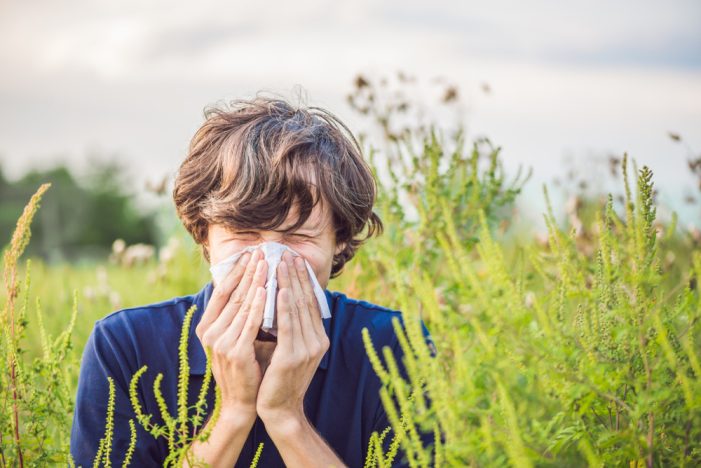By Esther Claudette Gittens | Editorial credit: Elizaveta Galitckaia / shutterstock.com
Ragweed pollen is one of the most common and potent allergens in North America, responsible for triggering seasonal allergic rhinitis, more commonly known as hay fever. Ragweed plants release tiny pollen particles into the air during late summer and fall, particularly between August and November, with peak levels typically occurring in September. For millions of individuals, exposure to ragweed pollen causes uncomfortable allergic reactions that, if untreated, can significantly impact quality of life. This analysis explores the symptoms, impacts on health, and effective medications and prevention strategies for managing ragweed allergies.
- What is Ragweed Pollen and How Does It Affect People?
Ragweed refers to a group of flowering plants that thrive in rural and urban environments, especially in open fields and roadsides. Each plant can produce up to a billion pollen grains per season, which are easily dispersed by the wind. This airborne quality makes ragweed pollen a major contributor to seasonal allergies.
The immune system of sensitive individuals mistakenly identifies the pollen as a harmful substance. This results in the release of histamine and other inflammatory chemicals, causing allergy symptoms. Ragweed pollen is especially problematic because it can travel great distances—up to 400 miles (643 km) from its source—ensuring widespread exposure across many regions
- Symptoms of Ragweed Allergy
The symptoms of ragweed pollen exposure are similar to those caused by other seasonal allergens. They can range from mild to severe and typically last throughout the pollen season unless treated. Common symptoms include:
- Sneezing and nasal congestion
- Runny nose and post-nasal drip
- Itchy eyes, nose, and throat
- Watery eyes and redness around the eyes
- Coughing or wheezing (in individuals with asthma)
- Sinus headaches and facial pressure
- Fatigue and irritability (due to sleep disturbances caused by nasal congestion)
In some cases, individuals with allergic asthma may experience worsened symptoms, such as shortness of breath and chest tightness during high-pollen days.
- Who is Most Affected by Ragweed Pollen?
Ragweed pollen particularly affects individuals with:
- Seasonal Allergic Rhinitis (Hay Fever): Ragweed is the most common trigger for fall allergies.
- Asthma: Exposure to pollen can worsen asthma symptoms, leading to more frequent asthma attacks.
- Oral Allergy Syndrome (OAS): Individuals allergic to ragweed may also experience cross-reactivity when eating certain foods (such as melons, bananas, and zucchini), causing itchiness or swelling in the mouth and throat
- Best Medications for Ragweed Allergy Management
There are several effective medications for managing ragweed pollen allergies. Depending on the severity of symptoms, doctors may recommend a combination of treatments. Below are the most common medications:
4.1 Antihistamines
Antihistamines block the histamine response, alleviating sneezing, itching, and runny noses. They are available as oral tablets, nasal sprays, and eye drops.
- Examples: Loratadine (Claritin), Cetirizine (Zyrtec), Fexofenadine (Allegra).
- Usage: Best taken preemptively before the start of allergy season.
4.2 Nasal Corticosteroids
Nasal sprays with corticosteroids reduce inflammation and nasal swelling. They are highly effective for moderate to severe symptoms.
- Examples: Fluticasone (Flonase), Budesonide (Rhinocort), and Mometasone (Nasonex).
- Usage: Most effective when used daily during allergy season.
4.3 Decongestants
Decongestants relieve nasal congestion by shrinking swollen blood vessels in the nose. They are available as oral pills and nasal sprays.
- Examples: Pseudoephedrine (Sudafed) and Oxymetazoline (Afrin).
- Caution: Nasal sprays should not be used for more than 3 consecutive days to avoid rebound congestion.
4.4 Allergy Eye Drops
Eye drops containing antihistamines or decongestants help soothe red, itchy, and watery eyes.
- Examples: Ketotifen (Zaditor) and Olopatadine (Pataday).
4.5 Immunotherapy (Allergy Shots or Tablets)
For individuals with severe or persistent allergies, immunotherapy can be a long-term solution. It involves receiving regular allergy shots or taking sublingual tablets to gradually desensitize the immune system to ragweed pollen.
- Example: Ragwitek, an FDA-approved tablet for ragweed allergy immunotherapy. This treatment typically starts months before allergy season to build immunity.
- Preventive Strategies and Environmental Controls
In addition to medications, individuals can take steps to minimize their exposure to ragweed pollen and reduce allergy symptoms. Here are some of the best prevention strategies:
5.1 Monitor Pollen Counts
- Keep track of daily pollen forecasts using weather apps or websites during allergy season.
- Stay indoors during peak pollen times (usually early morning and late afternoon).
5.2 Close Windows and Use Air Purifiers
- Keep windows and doors closed to prevent pollen from entering your home.
- Use HEPA air filters or purifiers to improve indoor air quality.
5.3 Shower and Change Clothes After Outdoor Activities
- Pollen can stick to hair, skin, and clothes. Showering after being outdoors helps prevent further exposure.
5.4 Use Masks and Sunglasses Outdoors
- Wear a mask to filter airborne allergens when spending time outside.
- Sunglasses can protect your eyes from pollen exposure, reducing itchiness and irritation.
5.5 Limit Outdoor Activities on High-Pollen Days
- Avoid activities such as gardening or exercising outdoors when pollen counts are high.
- Long-Term Management and Potential Cures
While there is no permanent cure for ragweed allergy, immunotherapy offers the best chance of long-term relief. Research shows that individuals who undergo allergy shots or sublingual tablets for several years can experience reduced sensitivity to ragweed pollen, significantly improving their quality of life over time.
Additionally, advancements in biologic therapies (like monoclonal antibodies) are being explored to treat severe allergies and asthma more effectively. These treatments aim to target specific pathways in the immune response, providing a new approach for managing allergic conditions.
- Conclusion
Ragweed pollen poses significant challenges to individuals prone to seasonal allergies, particularly those with hay fever and asthma. Its widespread presence and ability to travel long distances make avoidance difficult, but effective treatments and preventive measures are available. Medications such as antihistamines, nasal corticosteroids, and immunotherapy can help manage symptoms and improve comfort throughout the pollen season.
For long-term relief, immunotherapy offers the most promising approach by desensitizing the immune system to ragweed pollen. However, even with the best treatments, lifestyle changes such as monitoring pollen counts, using air purifiers, and minimizing outdoor exposure are essential components of allergy management.
With the right combination of medications, preventive strategies, and medical guidance, individuals can successfully manage ragweed pollen allergies and reduce their impact on daily life.

